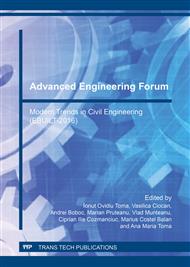p.327
p.335
p.346
p.352
p.358
p.366
p.372
p.380
p.389
Settlement Reduction of an Existing Road Earthworks Using Columns Obtained by Deep Soil Mixing Method
Abstract:
Deep soil mixing methods have been applied at international level for over 40 years on numerous ground improvement projects aimed to enhance the geotechnical performances. The chemical reactions and physical processes which take place after mixing the natural soil with different stabilizing agents lead to an increase in bearing capacity of the ground foundation for new or existing buildings, settlement reduction and/or stability for road and railway embankments, stability and/or seepage control for deep excavations. This paper presents the geotechnical design of columns obtained by mixing the soil with cement slurry in order to stabilize the manifesting settlements of the earth works of an existing road. Considering the geotechnical conditions of the analyzed site as input data, in this paper various dimensions and geometric configuration of the columns are evaluated, with specific purpose to determine an optimal solution that meets the technical performances of the project. The analysis was performed by numerical modeling using the finite element software Plaxis 2D, aiming to evaluate the strain state of both the treated and untreated soil. Although the stabilised elements are usually installed prior to the construction of the road structure, this article highlights the effectiveness of their application even in cases where the road structure already exists.
Info:
Periodical:
Pages:
358-365
Citation:
Online since:
March 2017
Price:
Сopyright:
© 2017 Trans Tech Publications Ltd. All Rights Reserved
Share:
Citation:


